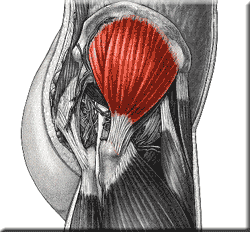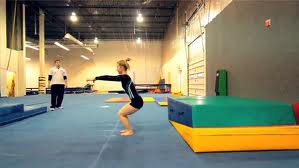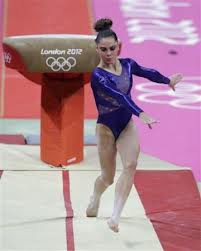21 Jul 2013
Gymnastics and the Glut Medius Muscle
Lauren Downes MSPT
Many people ask me "What are the most important muscles for a gymnast to strengthen to prevent injury?". Some obvious answers to people would be the abdominals and quadriceps, which both contribute to a gymnasts' strength and performance. As a physical therapist, I tend to view the body with more scrutiny, and my answer would be the gluteus medius muscle. The gluteus (glut) medius is one of the primary stabilizers of the hip joint, and connects the pelvis to the hip joint. (see picture)

Gymnastics involves a significant amount of weight transfer from one lower extremity to the other. To maintain proper balance and stability over a single leg, several muscle groups activate to create the proper lower extremity alignment, from the hip to the foot. The main muscle responsible for controlling the alignment and stability is the glut medius. When a person is balancing on one leg and bends the knee, the knee should remain in alignment over the toe. It is quite common to see the knee turn inwards and create what is called a 'valgus' angle at the knee joint. (see far right in picture)

The increase in this valgus angle will affect both a gymnast's balance and ability to appropriately use the muscles in the lower extremity for power development. If the glut medius muscle cannot sufficiently stabilize the hip joint, the femur bone (which begins at the hip joint socket and forms the top of the knee joint) will turn inward. It will also cause the contralateral side of the pelvis to drop. After picturing this position, picture a gymnast completing a simple turn on the beam or floor. During the turn, a gymnast needs to stay balanced over the foot. As the knee bends, the hips must stay level to maintain balance through the turn, and to control the gymnast's balance once finished. If the hip drops, a gymnast will not be able to maintain a center of balance in and out of the turn. This principle can apply to every skill that involves single leg stance, and also landings of dismounts and tumbling passes. If the gymnast's knees turn in during a landing, that athlete is more prone to knee injury.
The force of landing a high impact tumbling pass is very significant, and proper alignment of the ankles, knees, and hips is necessary to absorb the shock of the landing and prevent injury. In the pictures below, picture #1 shows proper landing technique. Picture #2 shows a faulty landing. Noticed the turn in (valgus angle) of the right knee. Weakness in the glute medius muscle can contribute to this turn-in and torque the knee joint.
1  2 2 
|